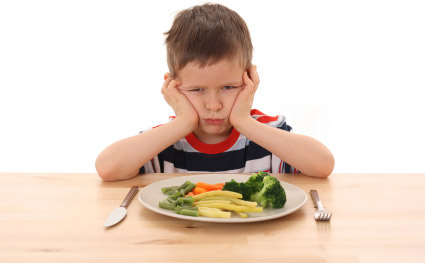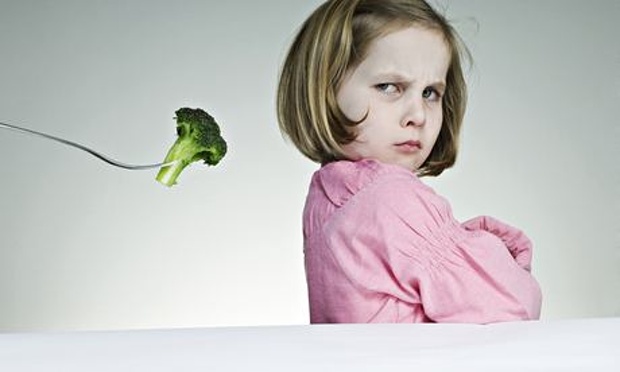HELPING A CHILD
WHO IS A PICKY EATER

WHO IS A PICKY EATER

One of the commonest complaints from Mums is about children who refuse to eat the food on their plates or else have restricted their choice of foods to a limited number that they like. For Mums this can cause massive anxiety and worry as they try and navigate their children into healthy eating habits.
So, how can you help your child to deal with the situation?
Well gaining understanding and insight into your child's needs is a natural starting point!
Children are born with a natural desire to be healthy and well and will, if left to their own devices, choose foods that suit their body’s requirements. Over time though, these desires may have become polluted with other people’s choices or with a number of different factors that affect their choice.
Our genetic mix pre-disposes us towards certain foods and rejects others. Despite so much information coming out to “slot” us into the “correct” food group, the best choices of what your body needs to enable you to stay healthy and well comes from within.
Despite your fears and worries about their survival, your child innately know what it needs. No two human beings are identical and we are all born with different taste buds with some people naturally preferring savory and some sweet and others a mix in between and yet meals times generally cater for the family as a whole.
Coupled with that is that different body types require and will crave different types of food and in the normal family “mix”, what is suitable for one member, may be contrary to the nutritional needs of the next.
A young baby’s natural instinct is to turn away from a food that he instinctively knows is “not suitable” for his body’s needs. His Mum, fearing the worse for the child, perseveres until the child gives in to his Mum's need to introduce a new food and consume the food that is on offer. Over time, this can “over-take” the body’s natural mechanism which has indicated that the food, for a myriad of different reasons, is “toxic” or “unsuitable” for the child.
Other factors that can Affect the Child:
Certain foods may get to represent “comfort food” to the child and make him feel good inside when they are eaten. This can come into effect from something as simple as a memory of a time when the child ate a particular food while sharing a relaxed and happy time with family or friends.
Alternatively, at another time, a food that is eaten when the child is churned up or upset (or when others around the child are emotionally angry or upset), may impact on the body in a negative way, causing a memory that trigger the opposite response and causes an emotional reaction to the food being presented.
Peer pressure can come into play. Rather than risking being ridiculed or even bullied, children may follow “food fads” that other children like or follow other children’s habits to enable them to feel more accepted by those around them.

Rejecting foods can also be a subtle way that a child exercises dominance over either one or both parents or seeks to cause a rift between parents. It can also be used as a way of getting attention if the child feels in some way neglected or over-looked by the needs of other siblings.
Allergies and intolerance are today becoming more and more commonplace and play havoc with a child’s eating patterns and their moods and emotions causing huge mood swings (from hypos to moody, sullen, uncooperative, tempers and tantrums) after eating and need to be factored into the equation.
One common feature of allergies is for the body to crave only the foods that they are allergic to and reject all others! For example when excessive sugar is consumed, it causes the body to keep craving the sugar foods or, in the case of Candida (yeast overgrowth often caused from excessive use of antibiotics, excessive bread, sugar or yeasty products), the body will naturally crave foods that feed the yeast that is growing within. Three days after a mother with a 18 month old “non-eater” removed allergy foods from her daughter’s diet, she not only started to eat her Mum out of house and home but her whole personality underwent an amazing change from a snarly, unsocial child to a happy and loving child.
Action Plan:
Build up a picture of the child's eating habits and emotional eating habit by:
• Observing the type of foods that your child wants to eat to see if any determinable pattern emerges
• Observe the mood of the child when they request food (tired; irritable; lethargic, etc.) and then observe their response after they eat
• Limit low nutritional foods like sugar (it creates great spikes of energy and then terrible lows that cause the body to desire more to sustain itself)
• Avoid heavily processed foods that contain little nutritional value
After that, what can you do to help your child?
If you find that there is an abnormal reaction after a meal, one of my first recommendations would be to get a hair testing done of the child. This can determine whether the child has intolerance to any foods and is as simple as taking a small length of hair and having it tested. Often in-tolerances are found in families and it is quite common to find that other family members may also be affected without knowing about it. (Hair testing sites can be located in your area through a Goggle search).
Take time to talk to your child and find out what in particular about the food that they do not like as the look, feel and even heat makes a difference to what they feel about it. Some people like their food hot and others prefer cold. One person I spoke to said that the textures of food more than anything else determined her likes or dislikes. Some like soft food and for others, the mushy stuff is yuk!!! Roast potatoes may be okay whereas boiled just tastes bad!
Make meal times a fun and relaxing time:
The look of the food is important which was highlighted in a recent television show when children were given water that was coloured but without flavouring (yellow for pineapple; red for raspberry, etc.) and all children reacted as if the water was flavoured!
Change the look… One Mum had wonderful results with her children by adding pureeing cooked spinach to mashed potatoes creating a spectacularly different "green-topped" Witchy-poo (Shepherd’s) Pie which everyone raved about! She also used beetroot juice in a similar way and always gets the kids to create wonderful names for the meals being created!
Present the children’s meals with fun and flair… make faces out of the food or better yet, encourage them to help with preparing, cooking and decoration of the plates. Kids can be creative and won’t resist eating the results!
Table top cooking… have meals that they can create themselves at the tables (sushi, tacos, wraps, hamburgers or pizzas, etc)… all you do is provide all the ingredients and let them create their own gourmet masterpieces. Admire and sample their creation and encourage them to sample yours.
Have a food show with the children preparing meals and everyone having to sample and judge the food.
The Energy Solution:
Over time, I have come across so many children who, much to their parents’ horror, eat virtually nothing and yet seem to have boundless energy and vitality. How can this be unless they are getting their nutrition in through another level… through the life-force energy of the food that they are eating rather than the nutritional aspect? Once this may have been thought of as fiction but today scientists have confirmed that the energy spark from the food that we are eating provides life-force to fuel us at a cellular level!
Food cooked in love and eaten in love increases the life-force energy of the food and feeds the mind, body and soul and provides life-force to sustain and maintain the health and well-being of both you and your children.
Relax and Go with the Flow:
Despite your frustration and worry, force feeding just does not work! It will create tension for all concerned. Although the child may consume the food that he is being fed, it is doubtful whether he will get any nutritional value out of it because the body needs to be in a relaxed state to release the necessary enzymes to process the food! So, why bother! Relax and surrender to the process. Children are resilient beyond belief and your child’s natural instinct to survive will not let the child starve! Meals are meant to be enjoyed so relax, let go and see what happens along the way!
Finally, a great book that changed the way I looked at food and food cravings, particularly with children was a cookbook called “A Natural Health Cookbook by Dorothy Hall and Carol Odell” which is not only a great cookbook but explained the reasons as to why our body craves certain foods. It helped me look at food in a different way and helped take away the pressure that I was feeling, at the time, with my own family’s eating habits.








